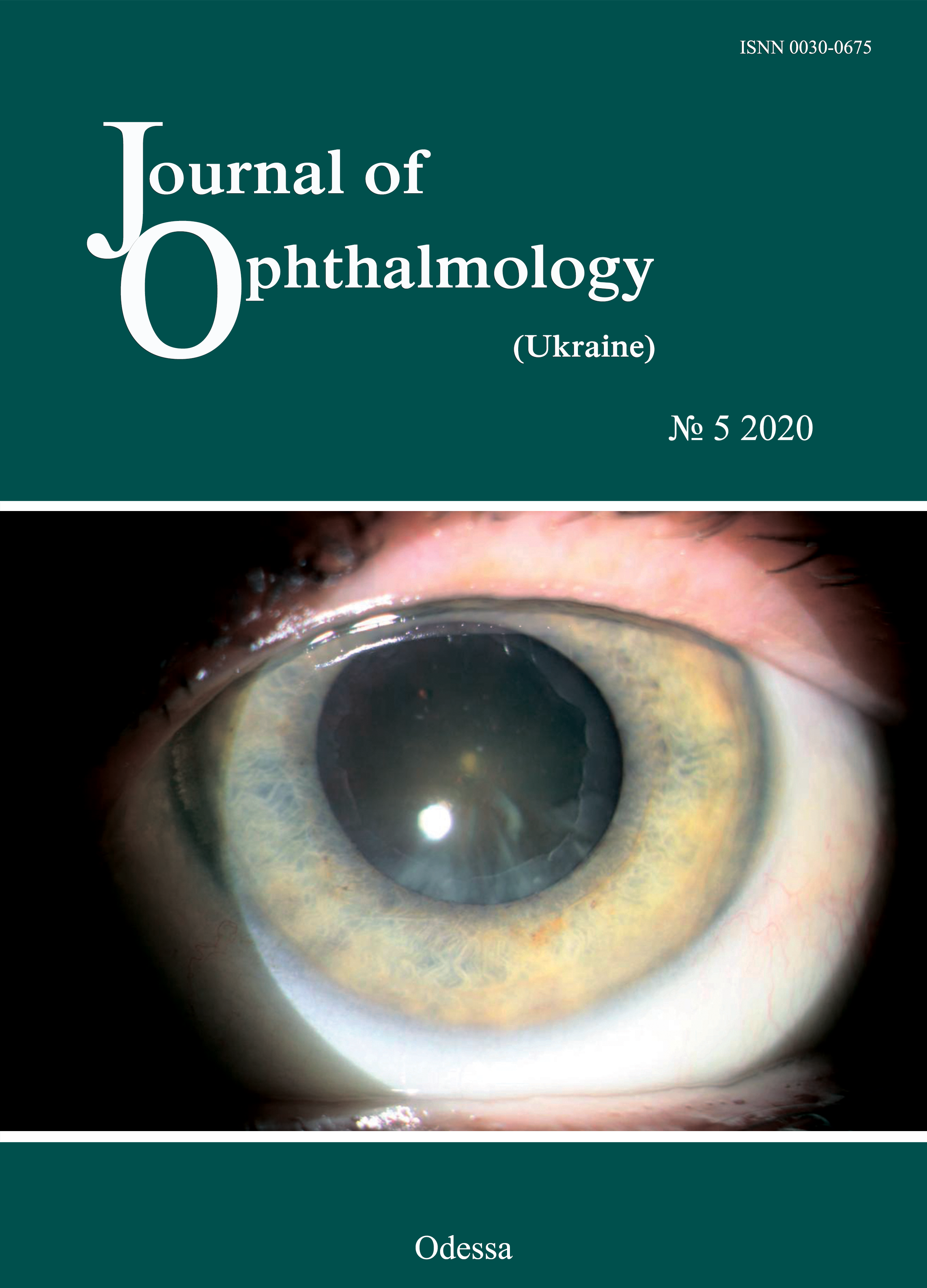Efficacy of adjunctive autologous serum in the comprehensive treatment of bacterial corneal ulcers in patients with diabetic mellitus
DOI:
https://doi.org/10.31288/oftalmolzh202052935Keywords:
diabetes mellitus, bacterial corneal ulcer, autologous serum, corneal sensitivityAbstract
Background: The presence of diabetic keratopathy associated with diabetic corneal neuropathy should be taken into account in the management of corneal inflammation in patients with diabetes mellitus.
Purpose: To determine the impact of adjunctive topical autologous serum eye drops on delayed healing of bacterial corneal ulcers in patients with type 1 diabetes mellitus (DM1).
Material and Methods: We retrospectively reviewed the results of observing 19 DM1 patients (19 eyes) with bacterial corneal ulcers who exhibited delayed healing of corneal ulceration and whose corneal smears and scrapings taken one week after initiation of treatment were bacteriologically negative. Patients had a routine eye examination (visual acuity, tonometry, and slit-lamp biomicroscopy of anterior and posterior eye segments), bacteriological studies, fluorescein dye test, anterior eye OCT and non-contact corneal esthesiometry. Patients of the control group (9 individuals) continued receiving only background therapy (topical antiseptics, antioxidants, repairing agents, artificial tears, and mydriatics and systemic anti-inflammatory agents), whereas patients of the main group began receiving autologous serum eye drops in addition to background therapy of topical antiseptics, mydriatics and systemic anti-inflammatory agents. Clinical picture data for day 1 (visit 1, before administering the treatment) and days 7 (when corneal samples and scrapings were re-taken), 14 (when bacteriology results became available and main group patients were additionally administered autologous serum), 17, 21 and 24 were analyzed.
Results: In DM1 patients with delayed healing of bacterial corneal ulcers, the use of adjunctive autologous serum eye drops after eradication of the offending microorganisms resulted in reductions in precorneal injection and size and depth of the ulcer defect and complete resolution of corneal infiltration and edema of the corneal tissue surrounding the ulcer as early as day 3, and recovery of all patients and a 32.6% improvement in corneal sensitivity on day 10.
Conclusion: Using adjunctive topical autologous serum eye drops after eradication of the offending microorganisms was found to be efficacious in the comprehensive treatment of delayed healing of bacterial corneal ulcers in patients with DM1.
References
1.Vieira-Potter VJ, Karamichos D, Lee DJ. Ocular complications of diabetes and therapeutic approaches. Biomed Res Int. 2016; 2016:3801570. https://doi.org/10.1155/2016/3801570
2.Kaji Y. Prevention of diabetic keratopathy. Br J Ophthalmol. 2005; 89:254-5.https://doi.org/10.1136/bjo.2004.055541
3.Austin A, Lietman Т, Rose-Nussbaumer J. Update on the Management of Infectious Keratitis. Ophthalmology. 2017:124(11):1678-89.https://doi.org/10.1016/j.ophtha.2017.05.012
4.Schulze SD, Sekundo W, Kroll P. Autologous serum for the treatment of corneal epithelial abrasions in diabetic patients undergoing vitrectomy. Am J Ophthalmol. 2006;142(2):207-11.https://doi.org/10.1016/j.ajo.2006.04.017
5.Troichenko LF. [Efficacy of the improved method for treating persistent epithelial defects and torpid ulcers of the cornea]. Cand Sc (Med) Thesis. Odesa: Filatov Institute of Eye Disease and Tissue Therapy. 2013. Ukrainian.
6.Geerling G, MacLennan S, Hartwig D. Autologous serum eye drops for ocular surface disorders. Br J Ophthalmol. 2004 Nov;88(11):1467-74.https://doi.org/10.1136/bjo.2004.044347
7.Lekhanont K, Jongkhajornpong P, Choubtum L, Chuckpaiwong V. Topical 100% serum eye drops for treating corneal epithelial defect after ocular surgery. Biomed Res Int. 2013;2013:521315.https://doi.org/10.1155/2013/521315
8.Zavoloka OV, Besditko PA, Lukhanin OO. Efficacy of a novel non-contact corneal esthesiometer in assessing the neurotrophic status of the cornea in type I diabetic patients with bacterial keratitis. J Ophthalmol (Ukraine). 2019;6:29-33.https://doi.org/10.31288/oftalmolzh201962933
9.Wang B, Yang S, Zhai H, Zhang Y, Cui C, Wang J, Xie L. A comparative study of risk factors for corneal infection in diabetic and non-diabetic patients. Int J Ophthalmol. 2018;11(1):43-7.
10.Grzybowski A, Kanclerz P, Huerva V, Ascaso F, Tuuminen R. Diabetes and Phacoemulsification Cataract Surgery: Difficulties, Risks and Potential Complications. J Clin Med. 2019;8(5):716.https://doi.org/10.3390/jcm8050716
11.Pflugfelder SC. Is autologous serum a tonic for the ailing corneal epithelium? Am J Ophthalmol. 2006 Aug;142(2):316-7.https://doi.org/10.1016/j.ajo.2006.05.002
Downloads
Published
How to Cite
Issue
Section
License
Copyright (c) 2025 О. В. Заволока, П. А. Бездітко

This work is licensed under a Creative Commons Attribution 4.0 International License.
This work is licensed under a Creative Commons Attribution 4.0 International (CC BY 4.0) that allows users to read, download, copy, distribute, print, search, or link to the full texts of the articles, or use them for any other lawful purpose, without asking prior permission from the publisher or the author as long as they cite the source.
COPYRIGHT NOTICE
Authors who publish in this journal agree to the following terms:
- Authors hold copyright immediately after publication of their works and retain publishing rights without any restrictions.
- The copyright commencement date complies the publication date of the issue, where the article is included in.
DEPOSIT POLICY
- Authors are permitted and encouraged to post their work online (e.g., in institutional repositories or on their website) during the editorial process, as it can lead to productive exchanges, as well as earlier and greater citation of published work.
- Authors are able to enter into separate, additional contractual arrangements for the non-exclusive distribution of the journal's published version of the work with an acknowledgement of its initial publication in this journal.
- Post-print (post-refereeing manuscript version) and publisher's PDF-version self-archiving is allowed.
- Archiving the pre-print (pre-refereeing manuscript version) not allowed.












